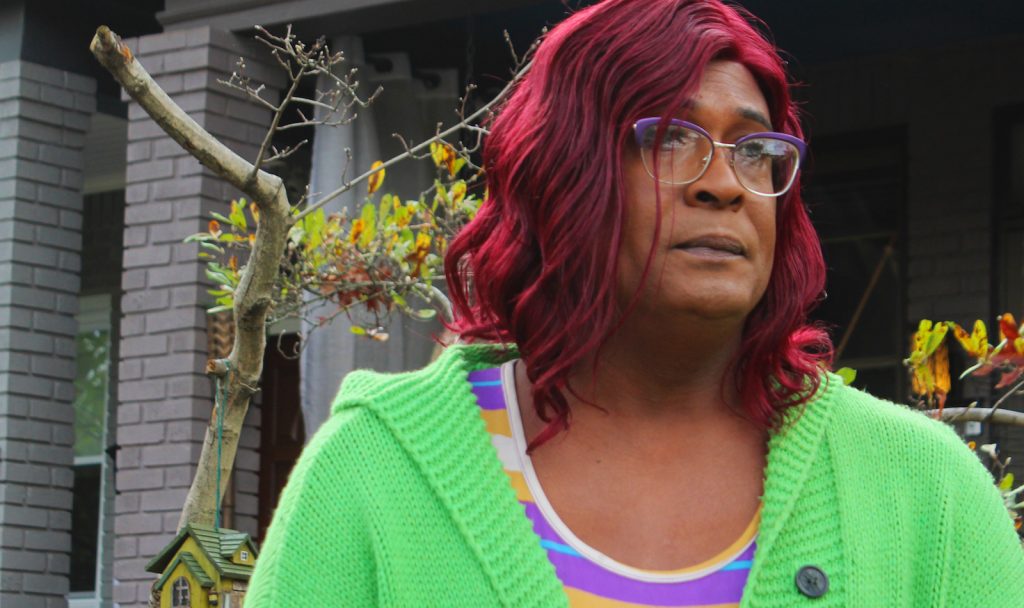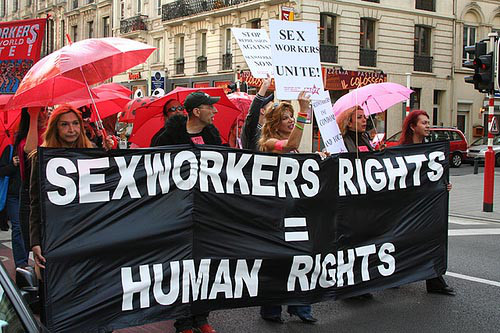Chapter 18: Sex Workers’ Rights and Human Trafficking: When Human Rights Movements Violate Human Rights
CHAPTER 18: SEX WORKERS’ RIGHTS AND HUMAN TRAFFICKING: WHEN HUMAN RIGHTS MOVEMENTS VIOLATE HUMAN RIGHTS
Companion Website by: Samuel Ellyson and Maggie Flanagan
TABLE OF CONTENTS:
- More About the Panelists
- Chapter Study Resources
- Chapter Summary
- Additional Notable Mentions
- Sex Work And Human Trafficking
- Laws/Legality Of Sex Work
- SESTA and FOSTA
- Laws Against Various Forms Of Sex Work
- Criminalization Increases Exploitation
- Harm Reduction Rather Than Criminalization
- Legislation For Decriminalization Of Sex Work
- ‘DECRIM NOW’ Campaign
- “Partial DECRIM”, The Nordic Model – Sex Workers Still Suffering
- Prohibition Of Sex Work
- Pornography Is Legal But Sex Work Isn’t – Can’t Sell Sex On An Individual Basis
- Catholic Legion Of Decency Thought White Slavery Films About Brothels Would Morally Corrupt People/Motion Picture Production Code
- Gender Marker Bill In Arizona
- Police Interaction
- Media, Stigma, and Stereotypes
- Media Stereotypes Of Sex Workers
- Narratives And Perceptions Around Male Sex Workers/Trans Sex Workers/People Of Color Who Are Sex Workers
- Sex Workers Have Internalized Self-Stigma
- Stigma of Transgender Women
- Isolation Of Sex Workers Because They Can’t Be Honest
- Media Coverage Of The Deaths Of Trans Women / Trans Issues In General
- Marginalized Groups
- Groups/Projects/Events
- United Nations
- People Of Color and Trans People
- Other Topics
- Services/Resources/Activities
- Contribute Resources!
MORE ABOUT THE PANELISTS:

Arizona

Washington DC

Arizona
Juliana Piccillo
Decriminalizing Sex Work with Juliana Piccilli & Raquel Velasquez
Tamika Spellman
VIDEOS FEATURING THE PARTICIPANTS:
CHAPTER STUDY RESOURCES:
USE THESE TO HELP FURTHER YOUR UNDERSTANDING OF THE CHAPTER!
CHAPTER SUMMARY:
The speakers in this chapter offer insights into the lived reality of sex workers and offer their views on how sex workers rights’ in the US are threatened by the anti-human trafficking movement. They outline the harms caused by the criminalization of sex work and the conflation between sex workers and sex trafficking victims in the US. Juliana offers an historic overview of how sex workers are portrayed in art and popular culture, a portrayal which leads to stigmatization and supports the criminalization of sex work. Tamika speaks compellingly of her experience doing sex work on the streets of Washington DC and now advocating for decriminalization of sex work. Monica describes how she was a Social Work student at Arizona State University in Phoenix and was arrested for allegedly practicing sex work during a sting operation that was organized in part by a Social Work professor at ASU.
Despite a wealth of funding going to anti-trafficking movements in the US, there have been relatively few confirmed instances of human trafficking, in part, because the focus is overwhelmingly on sex trafficking. As Tamika Spellman says, “We do not have the number of people coming across the border like they do in other countries being trafficked into sex work. We have plenty of people coming across the border to go to work in the farm industry. We have plenty of people being trafficked across the border to work in the construction industry, but they’re not talking about them. They only talk about sex trafficking. Where are the laws for the other ones? They’re not concerned about them because they’re tied to legal businesses.”
The situation in other countries is not addressed here at length. Many countries have greater prevalence of sex trafficking, along with worse rates of labor trafficking. At the same time, many countries have changed their laws to either completely or partially decriminalize sex work. In the US though, consensual sex work and sex trafficking are often conflated, and thus harming consensual sex workers who are over-policed.
This chapter intersects nicely with mass incarceration, activism, LGBTQ rights, destigmatization, activist strategies, gender and human rights, intersectionality….
ADDITIONAL NOTABLE MENTIONS:
CAROL LEIGH, SCARLOT HARLOT:
ROBYN FEW, SEX WORKERS’ OUTREACH PROJECT (SWOP) IN SAN FRANCISCO:
ZOE SPEARS AND ASHANTI CARMON:
KANDIS CAPRI:
JULES KIM:
DR. LOURDES ASHLEY HUNTER:
SEX WORK AND HUMAN TRAFFICKING:
HUMAN TRAFFICKING:
“WHITE SLAVERY” PANIC IN THE 20TH CENTURY IN THE US:
UNDERAGE ENTRY INTO SEX WORK:
TRAFFICKING MYTHS, FACTS, AND STATISTICS:
CONFLATING CONSENSUAL SEX WORK WITH TRAFFICKING:
LACK OF CONCERN AROUND SEX WORK SAFETY:
LAWS/LEGALITY OF SEX WORK:
SESTA AND FOSTA:
LAWS AGAINST VARIOUS FORMS OF SEX WORK:
CRIMINALIZATION INCREASES EXPLOITATION:
HARM REDUCTION RATHER THAN CRIMINALIZATION:
LEGISLATION FOR DECRIMINALIZATION OF SEX WORK:
What about Legalization of Prostitution?
Experts Back Decriminalization as the Best Means to Enhance the Rights of Sex Workers
My Body, My Choice: Why the Decriminalization of Sex Work is Essential for Reproductive Justice
Ten Reasons to Decriminalize Sex Work
The Movement to Decriminalize Sex Work, Explained
Sex Work Decriminalization Efforts Leave Workers, Advocates, and Survivors Divided
‘DECRIM NOW’ CAMPAIGN:
“PARTIAL DECRIM”, THE NORDIC MODEL – SEX WORKERS STILL SUFFERING:
PROHIBITION OF SEX WORK:
PORNOGRAPHY IS LEGAL BUT SEX WORK ISN’T – CAN’T SELL SEX ON AN INDIVIDUAL BASIS:
CATHOLIC LEGION OF DECENCY THOUGHT WHITE SLAVERY FILMS ABOUT BROTHELS WOULD MORALLY CORRUPT PEOPLE/MOTION PICTURE PRODUCTION CODE:
Condemned and Morally Offensive: The Forbidden Fruit of the Catholic Legion of Decency
The Catholic Crusade Against the Movies, 1940-1975
“Complete Nudity is Never Permitted”: The Motion Picture Production Code of 1930
The End of American Film Censorship
What was Hollywood’s Hays Code: A Comprehensive Guide
Hollywood Censored: The Production Code Administration and the Hollywood Film Industry, 1930-1945
Morality and Entertainment: The Origins of the Motion Picture Production Code
GENDER MARKER BILL IN ARIZONA:
POLICE INTERACTION:
THE CONSTANT THREAT OF ARREST FOR SEX WORKERS:
CONSEQUENCES OF ARREST FOR SEX WORK:
PEER TASK FORCE AS PART OF THE POLICE DEPARTMENT – GAY AND LESBIAN LIAISON UNIT:
ACCOUNTABILITY BEHIND BODY CAM FOOTAGE OF POLICE:
PHOENIX SPONSORED PROGRAM PROJECT ROSE – POLICE STING OPERATIONS FOCUSED ON SEX WORK:
MEDIA, STIGMA, AND STEREOTYPES:
MEDIA STEREOTYPES OF SEX WORKERS:
NARRATIVES AND PERCEPTIONS AROUND MALE SEX WORKERS/TRANS SEX WORKERS/PEOPLE OF COLOR WHO ARE SEX WORKERS:
The Lived Experiences of Male Sex Workers: A Global Qualitative Meta-Synthesis
New Pleasures and Old Dangers: Reinventing Male Sex Work
Being Trans in the World of Sex Work
‘Playing Two People’: Exploring Trans Women’s Experiences in Sex Work
Black Women and Sex Work | Recent Research
Sex Workers of Color Defining Their Own Pathways to Radical Communal Healing
SEX WORKERS HAVE INTERNALIZED SELF-STIGMA:
STIGMA OF TRANSGENDER WOMEN:
ISOLATION OF SEX WORKERS BECAUSE THEY CAN’T BE HONEST:
MEDIA COVERAGE OF THE DEATHS OF TRANS WOMEN / TRANS ISSUES IN GENERAL:
MARGINALIZED GROUPS:
YOUNG, OFTEN IMMIGRANT, WOMEN LURED INTO A BROTHEL:
MIGRANTS AND TRANSGENDER SEX WORKERS – RIGHTS:
SEX WORK AS A WAY OF SURVIVAL FOR MANY TRANSGENDER PEOPLE, PEOPLE IN THE LGBT COMMUNITY, AND PEOPLE OF COLOR:
BLACK TRANS WOMEN NEED TO BE HIGHLIGHTED DURING THE BLM MOVEMENT:
GROUPS/PROJECTS/EVENTS:
SEX WORKER RIGHTS GROUPS:
SEX WORKER ADVOCATES COALITION (SWAC):
OUTLAW PROJECT:
INTERNATIONAL AIDS CONFERENCE:
BLACK TRANS FUND FROM GROUNDSWELL:
“ABSTINENCE ONLY”:
UNITED NATIONS:
SEX WORKERS AT THE UN:
UPR RECOMMENDATIONS ON SEX WORK TO THE US:
PEOPLE OF COLOR AND TRANS PEOPLE:
PEOPLE OF COLOR AND TRANS PEOPLE MAKING MOVIES ABOUT AND FOR THEM:
COLORISM, WHITE SUPREMACY:
TRANSPHOBIA AND HOMOPHOBIA IN COMMUNITIES OF COLOR:
OTHER TOPICS:
TRAFFIC IN SOULS:
WAR ON DRUGS:
STATE-SANCTIONED VIOLENCE:
TERF (TRANS-EXCLUSIONARY, RADICAL FEMINISTS):
SERVICES/RESOURCES/ACTIVITIES:
HARM REDUCTION SERVICES: CONDOMS, STD TEST KITS:
RESOURCES FOR SEX WORKERS:
RESOURCES FOR ALLIES OF SEX WORKERS:
RESOURCES FOR VICTIMS OF HUMAN TRAFFICKING/PREVENTION OF HUMAN TRAFFICKING:
STUDENT ACTIVITIES/HOW TO TEACH STUDENTS ABOUT SEX WORK:

